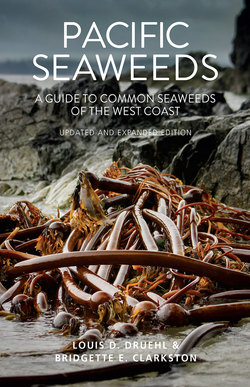Читать книгу Pacific Seaweeds - Louis Druehl - Страница 18
ОглавлениеPacific Seaweeds
18
Seaweed Life Histories
The life cycle of humans, like that of almost all animals, is simple and straightforward. Your cells are diploid (having two sets of chromosomes). Some of these cells will undergo meiosis, a type of cell division that reduces the chromosomes to one set, producing haploid (one set of chromosomes) eggs or sperm. The fusion of the egg and sperm introduces two chromosome sets into a zygote. The zygote increases in cell number by mitosis, a type of cell division that does not change the number of chromosome sets, and develops into a mature diploid individual.
The life cycle of plants, particularly the seaweeds, is much more elaborate and varied than that found in animals. In plants, the products of meiosis are rarely eggs and sperm but rather a haploid plant body. Thus a plant can have two bodies, a haploid one and a diploid one. The diploid body is called the sporophyte because it produces spores by meiosis. These spores give rise to the haploid body, which is called the gametophyte because it gives rise to gametes (eggs, sperm or other sexually active cells).
The gametophytes and sporophytes may appear very similar, a condition referred to as isomorphic (same form), or they may be dissimilar, or heteromorphic (different form). The green seaweed Ulva (sea lettuce, p. 62) has a life cycle that alternates between morphologically similar gametophytes and sporophytes (isomorphic; Figure 5). Some seaweeds have gametophyte and sporophyte generations that are markedly different in appearance (heteromorphic). Green seaweeds such as the green filamentous Urospora (p. 53) have a single-celled sporophyte and a multicellular filamentous gametophyte. At the other extreme is the brown seaweed Fucus (p. 181), where the sporophyte is multicellular and the gametophyte is reduced to eggs and sperm as in the typical animal life cycle (Figure 6). In between are many species whose gametophytes and sporophytes are both multicellular but of different sizes and forms. In the kelp Nereocystis (p. 226), the sporophyte is a very large plant—often longer than 30 m (98 ft)—and the gametophyte is a small filamentous plant, not visible to the naked eye (Figure 7).
Speaking of kelp sex, legend has it that Professor Dieter Müller, University of Konstanz, Germany, discovered a gin-like smell in his lab that he attributed to his graduate students. The students denied any wrong-doing. Müller determined the aroma was a brown algal pheromone. In kelp, the pheromone lamoxirene, produced by the female gametophyte, has two
